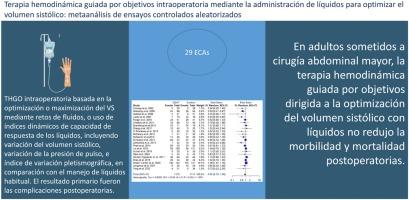Terapia hemodinámica guiada por objetivos mediante la administración de líquidos para optimizar el volumen sistólico: metaanálisis de ensayos controlados aleatorizados
IF 0.8
Q3 ANESTHESIOLOGY
Revista Espanola de Anestesiologia y Reanimacion
Pub Date : 2024-12-01
DOI:10.1016/j.redar.2024.04.004
引用次数: 0
Abstract
Objective
To evaluate the clinical impact of optimizing stroke volume (SV) through fluid administration as part of goal-directed hemodynamic therapy (GDHT) in adult patients undergoing elective major abdominal surgery.
Methods
This systematic review and meta-analysis was conducted in accordance with the Preferred Reporting Items for Systematic Reviews and Meta-Analyses (PRISMA) statement and was registered in the PROSPERO database in January 2024. The intervention was defined as intraoperative GDHT based on the optimization or maximization of SV through fluid challenges, or by using dynamic indices of fluid responsiveness, including stroke volume variation, pulse pressure variation, and plethysmography variation index compared to usual fluid management. The primary outcome was postoperative complications. Secondary outcome variables included postoperative acute kidney injury (AKI), length of stay (LOS), intraoperative fluid administration, and 30-day mortality.
Results
A total of 29 randomized controlled trials (RCTs) met the inclusion criteria. There were no significant differences in the incidence of postoperative complications (RR 0.89; 95% CI, 0.78 to 1.00), postoperative AKI (OR 0.97; (95% IC, 0.55 to 1.70), and mortality (OR 0.80; 95% CI, 0.50 to 1.29). GDHT was associated with a reduced LOS compared to usual care (SMD: −0.17 [−0.32; - 0.03]). The subgroup in which hydroxyethyl starch was used for hemodynamic optimization was associated with fewer complications (RR 0.79; 95% CI, 0.65 to 0.94), whereas the subgroup of patients in whom crystalloids were used was associated with an increased risk of postoperative complications (RR 1.08; 95% CI, 1.04 to 1.12).
Conclusions
In adults undergoing major surgery, goal-directed hemodynamic therapy focused on fluid-based stroke volume optimization did not reduce postoperative morbidity and mortality.

利用输液优化脑卒中容量的目标引导血流动力学疗法:随机对照试验荟萃分析
目的评价通过液体给药优化脑卒中容量(SV)作为目标导向血流动力学治疗(GDHT)的一部分在成人择期腹部大手术中的临床效果。方法本研究按照PRISMA (Preferred Reporting Items for systematic Reviews and meta-analysis)声明进行系统评价和荟萃分析,并于2024年1月在PROSPERO数据库中注册。干预被定义为术中GDHT,基于通过流体挑战优化或最大化SV,或通过使用流体反应性的动态指标,包括与常规液体管理相比的脑卒中容积变化、脉压变化和容积图变化指数。主要结局为术后并发症。次要结局变量包括术后急性肾损伤(AKI)、住院时间(LOS)、术中给液和30天死亡率。结果共有29项随机对照试验(RCTs)符合纳入标准。两组术后并发症发生率差异无统计学意义(RR 0.89;95% CI, 0.78 ~ 1.00),术后AKI (OR 0.97;(95% IC, 0.55 ~ 1.70)和死亡率(OR 0.80;95% CI, 0.50 - 1.29)。与常规治疗相比,GDHT与LOS降低相关(SMD: - 0.17 [- 0.32;- 0.03])。羟乙基淀粉用于血流动力学优化的亚组并发症较少(RR 0.79;95% CI, 0.65 ~ 0.94),而使用晶体药物的患者亚组与术后并发症风险增加相关(RR 1.08;95% CI, 1.04 - 1.12)。结论在接受大手术的成年人中,以液体为基础的卒中容量优化为重点的目标导向血流动力学治疗并没有降低术后发病率和死亡率。
本文章由计算机程序翻译,如有差异,请以英文原文为准。
求助全文
约1分钟内获得全文
求助全文
来源期刊

Revista Espanola de Anestesiologia y Reanimacion
ANESTHESIOLOGY-
CiteScore
1.80
自引率
15.40%
发文量
113
审稿时长
82 days
 求助内容:
求助内容: 应助结果提醒方式:
应助结果提醒方式:


